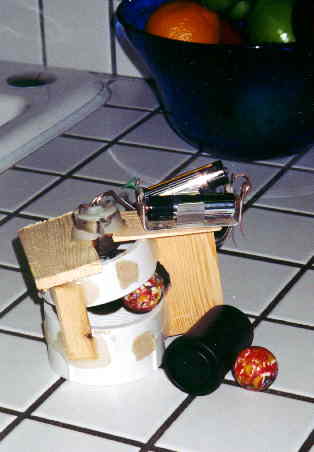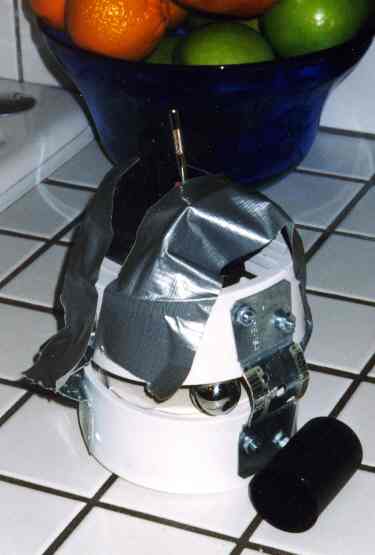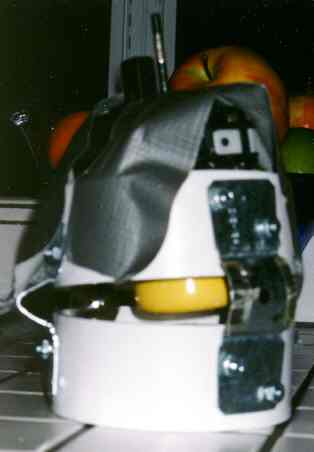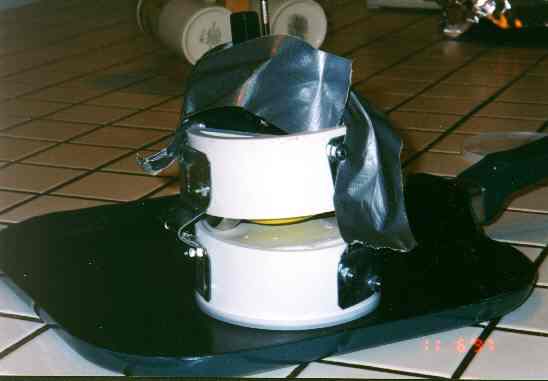GIT Building Page
New Technology Engineering in Progress:
The Gyroscopic Inertial Thruster (GIT)
Visit my Homepage:
HERE
Visit These Other Fascinating GIT Pages!
David Cowlishaw (GIT Inventor)
Amanda Gilbert
Britt Beaubian
NEW! My Third GIT! and an attempt at the dreaded PENDULUM TEST!
HERE
NOTE: I would like to hear from other GIT builders,
especially any credible reports of a GIT passing the
pendulum test:
E-Mail: Dann McCreary
I am busy these days doing some applied engineering in
a new technology - working on an invention by David Cowlishaw. This
invention is the Gyroscopic Inertial Thruster, or GIT. The
inventor claims that it produces a unidirectional force, or reactionless
thrust - that is, force which can result in the motion of the GIT (and
any conveyance or apparatus connected to it) without pushing or throwing
any mass in the opposite direction!
I have been interested in "reactionless" propulsion
for more than thirty years, having been quite excited by reports about
the
Dean Drive
(first seen by me in Popular Mechanics), another
"unidirectional force" machine. The Dean Drive was eventually
(and loudly) proclaimed to be unworkable. To discover another drive which
appears to be a real contender has been very exciting; the more I think
through the theory, the more persuaded I have been as to its validity.
If this invention works as David describes, then I expect
we will see the colonization of the Moon and Mars begun in my lifetime.
:)
The development of the GIT will also mark the beginning
of the end of road building. :)
The GIT could also lift Nana and
Papa's Flying House!!! :)
News Flash! Son of Mini Git Operational!
Well, last night I slapped together a "micro-git". This one
is built from a 2" PVC pipe fitting. It has several interesting features:
It is small, yet it showed noticeable thrust, moving across a smooth
coffee table surface.
This GIT was "slapped together" in almost no time; anyone can make one; I
sized the race "gear-ratio" empirically by using cardboard and hot-melt
glue to hold one side temporarily while I "fit" the orbital to the other
more open side. The race supports are simply pieces of wood (pine shims)
cut to size and hot-melt glued in place.
The orbital is a "super-ball", a high-density plastic/rubber ball. Using
a rubber ball rather than steel or glass solves the problem of "slipping",
providing positive rolling traction all around the race and against any
type of drive wheel.
 Unfortunately, after a short while of operation my drive wheel (from a
spool of thread, hot-melt glued to the motor shaft!) gave out. Yes,
it was a kludge! Yes, it is a little too large and not perfectly round!
But the GIT did move, and I could feel the "pull" when I held its tail!
Unfortunately, after a short while of operation my drive wheel (from a
spool of thread, hot-melt glued to the motor shaft!) gave out. Yes,
it was a kludge! Yes, it is a little too large and not perfectly round!
But the GIT did move, and I could feel the "pull" when I held its tail!
Well, I tried a pendulum test; that was disappointing.
I hung a balsa plank by four threads from a 2X4 laid across the top of
some open closet doors; to this I taped the "micro-git", facing along
the long axis of the plank. I set a trash can at the back end of the
plank as a "benchmark", started the GIT and only observed a little
oscillation back and forth.
I don't consider this conclusive yet at all; I really need a GIT with
perhaps more orbitals, more speed, and better craftsmanship.

Meanwhile, I am back to trying to build my third GIT. Number One (described
below) is STILL waiting for some parts from the machine shop. (sigh!)
The bottom line? Something is going on here, and I'm ramping up for
more GIT building, more tests (maybe the water test next for "micro?"),
and improved engineering. If only there were about 80 hours in a day!
Here are some pictures of my first feeble attempt at building
a GIT. (I owe a debt of gratitude to James Hurl of Australia for
some of his ideas for simplifying GIT construction.)
This picture shows the GIT, with one of the orbitals visible,
next to a film can for scale. (Note the duct tape! I was anxious to get
this baby moving and see what it would do!)

The next picture is from a different angle, with the electric
motor driven friction wheel visible. (one of the problems with this first
attempt is that the wheel is too small, and it kind of flings the
orbitals around the race).

The final picture shows the GIT (barely) moving across
a "frictionless" surface (teflon fry-pan).

The next stage of GIT construction will occur when I get
some parts back from the machine shop - a properly sized drive wheel, an
arbor shaft to drive it, and a shaft adapter to connect it to an electric
motor "borrowed" from an remote-control glider.
The experiment of greatest interest to me is the "pendulum
test" - this involves hanging the thruster as a pendulum,
observing that the pendulum is "plumb" - i.e. vertical with respect
to gravity, and then turning on the GIT. If the GIT is truly producing
an inertial thrust, the pendulum will move off plumb in the
direction of the thrust and remain off plumb as long as the
GIT is running.
For details of the history and development of the GIT,
please visit the inventor's
amazing home page. Thanks, David!
For progress reports on my personal experiments with the
GIT, drop back here from time to time.
 Unfortunately, after a short while of operation my drive wheel (from a
spool of thread, hot-melt glued to the motor shaft!) gave out. Yes,
it was a kludge! Yes, it is a little too large and not perfectly round!
But the GIT did move, and I could feel the "pull" when I held its tail!
Unfortunately, after a short while of operation my drive wheel (from a
spool of thread, hot-melt glued to the motor shaft!) gave out. Yes,
it was a kludge! Yes, it is a little too large and not perfectly round!
But the GIT did move, and I could feel the "pull" when I held its tail!


